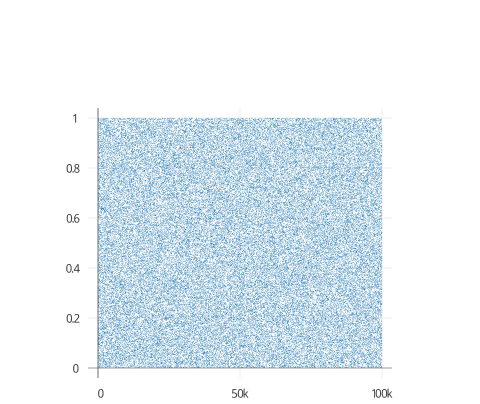NAME
Chart::Plotly::Trace::Pointcloud - The data visualized as a point cloud set in `x` and `y` using the WebGl plotting engine.
VERSION
version 0.018
SYNOPSIS
use HTML::Show;
use Chart::Plotly;
use Chart::Plotly::Trace::Pointcloud;
my $pointcloud = Chart::Plotly::Trace::Pointcloud->new( x => [ 1 .. 100000 ], y => [ map { rand() } ( 1 .. 100000 ) ] );
HTML::Show::show( Chart::Plotly::render_full_html( data => [$pointcloud] ) );DESCRIPTION
The data visualized as a point cloud set in `x` and `y` using the WebGl plotting engine.
Screenshot of the above example:

This file has been autogenerated from the official plotly.js source.
If you like Plotly, please support them: https://plot.ly/ Open source announcement: https://plot.ly/javascript/open-source-announcement/
Full reference: https://plot.ly/javascript/reference/#pointcloud
DISCLAIMER
This is an unofficial Plotly Perl module. Currently I'm not affiliated in any way with Plotly. But I think plotly.js is a great library and I want to use it with perl.
METHODS
TO_JSON
Serialize the trace to JSON. This method should be called only by JSON serializer.
type
Trace type.
ATTRIBUTES
customdata
Assigns extra data each datum. This may be useful when listening to hover, click and selection events. Note that, *scatter* traces also appends customdata items in the markers DOM elements
customdatasrc
Sets the source reference on plot.ly for customdata .
hoverinfo
Determines which trace information appear on hover. If `none` or `skip` are set, no information is displayed upon hovering. But, if `none` is set, click and hover events are still fired.
hoverinfosrc
Sets the source reference on plot.ly for hoverinfo .
hoverlabel
ids
Assigns id labels to each datum. These ids for object constancy of data points during animation. Should be an array of strings, not numbers or any other type.
idssrc
Sets the source reference on plot.ly for ids .
indices
A sequential value, 0..n, supply it to avoid creating this array inside plotting. If specified, it must be a typed `Int32Array` array. Its length must be equal to or greater than the number of points. For the best performance and memory use, create one large `indices` typed array that is guaranteed to be at least as long as the largest number of points during use, and reuse it on each `Plotly.restyle()` call.
indicessrc
Sets the source reference on plot.ly for indices .
legendgroup
Sets the legend group for this trace. Traces part of the same legend group hide/show at the same time when toggling legend items.
marker
name
Sets the trace name. The trace name appear as the legend item and on hover.
opacity
Sets the opacity of the trace.
selectedpoints
Array containing integer indices of selected points. Has an effect only for traces that support selections. Note that an empty array means an empty selection where the `unselected` are turned on for all points, whereas, any other non-array values means no selection all where the `selected` and `unselected` styles have no effect.
showlegend
Determines whether or not an item corresponding to this trace is shown in the legend.
stream
text
Sets text elements associated with each (x,y) pair. If a single string, the same string appears over all the data points. If an array of string, the items are mapped in order to the this trace's (x,y) coordinates. If trace `hoverinfo` contains a *text* flag and *hovertext* is not set, these elements will be seen in the hover labels.
textsrc
Sets the source reference on plot.ly for text .
uid
visible
Determines whether or not this trace is visible. If *legendonly*, the trace is not drawn, but can appear as a legend item (provided that the legend itself is visible).
x
Sets the x coordinates.
xaxis
Sets a reference between this trace's x coordinates and a 2D cartesian x axis. If *x* (the default value), the x coordinates refer to `layout.xaxis`. If *x2*, the x coordinates refer to `layout.xaxis2`, and so on.
xbounds
Specify `xbounds` in the shape of `[xMin, xMax] to avoid looping through the `xy` typed array. Use it in conjunction with `xy` and `ybounds` for the performance benefits.
xboundssrc
Sets the source reference on plot.ly for xbounds .
xsrc
Sets the source reference on plot.ly for x .
xy
Faster alternative to specifying `x` and `y` separately. If supplied, it must be a typed `Float32Array` array that represents points such that `xy[i * 2] = x[i]` and `xy[i * 2 + 1] = y[i]`
xysrc
Sets the source reference on plot.ly for xy .
y
Sets the y coordinates.
yaxis
Sets a reference between this trace's y coordinates and a 2D cartesian y axis. If *y* (the default value), the y coordinates refer to `layout.yaxis`. If *y2*, the y coordinates refer to `layout.xaxis2`, and so on.
ybounds
Specify `ybounds` in the shape of `[yMin, yMax] to avoid looping through the `xy` typed array. Use it in conjunction with `xy` and `xbounds` for the performance benefits.
yboundssrc
Sets the source reference on plot.ly for ybounds .
ysrc
Sets the source reference on plot.ly for y .
AUTHOR
Pablo Rodríguez González <pablo.rodriguez.gonzalez@gmail.com>
COPYRIGHT AND LICENSE
This software is Copyright (c) 2018 by Pablo Rodríguez González.
This is free software, licensed under:
The MIT (X11) License